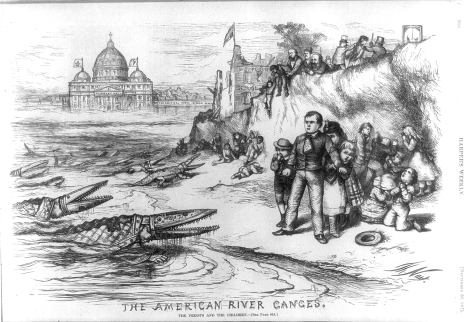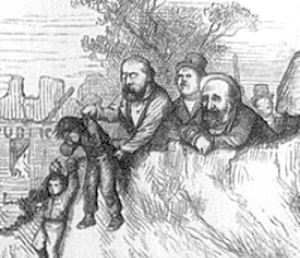The concern of Roman Catholic interference in public education is brilliantly rendered in what many scholars regard as Nast’s most famous, and well-executed anti-Catholic image. The image was published twice in Harper’s Weekly. The first, on September 30, 1871, implicated Tweed, and reprised on May 8, 1975, with Tweed removed.

A Chinese boy on his hands and knees attempts to flee and Native American and African American children press up against the cliff with nowhere to escape. Nast shared a Republican, utopian vision that public schools should be open to all children, regardless of race, creed or ethnicity, and he drew many images of an idealized public school system that included a diverse student body learning in harmony. With the Catholic initiative to create their own schools with the support of public funds expressly underway with support from Tweed, Nast feared separate sectarian schools for all ethnic and racial groups.
“Nast believed that bringing children together into the public sphere, under democratic control, muted their religious and racial differences and molded a unified, multiethnic [sic]American society” (Justice 174). Tweed and the Roman Catholic Church interfered with that vision.


[/caption]At the center top of the image, a U.S. Public School is seen crumbling and an inverted American flag, a sign of distress, flies prominently. On the other side of the river, stands a Vatican shaped “Tammany Hall” (This was changed in 1875 to read “Political Roman Catholic Church.”) Flags of the Papal Coat of Arms, and the Irish harp, fly atop the side domes. Attached to the right of the RC Church is the “Political Roman Catholic School.”
In Harper’s Weekly, the image was accompanied by an essay written by Eugene Lawrence, a nativist and frequent contributor to the periodical. Lawrence blamed the Catholics for the end of the public school system and the Catholic aim “to destroy our free schools, and perhaps our free institutions has been for many years the constant aim of the extreme section of the Romish Church.” The essay continues its attack on Jesuits and the daring aggressive spirit of the ultramontane Irish Catholics who govern New York. The author also touts brave European governments who have dared to challenge Roman Catholic influence of their schools and other institutions.
The institutions that managed New York Public Schools claimed their schools provided non-sectarian education. Catholics disagreed, noting Protestant-based libraries, textbooks and “the daily reading of the Protestant version of the Bible” in classrooms as an unsatisfactory environment for learning (Heuston 54).
“The establishment of a new state school systems in the United states seemed to substantiate Catholic fears that the attitudes of European secularists were taking root in America” (Heuston 169). Prior to the Civil War, Catholics wanted to participate in the public school system without endangering their faith. Catholics were encouraged to pursue the issue after New York Whig Governor William Seward suggested in 1840 that state aid might be given to Catholic schools (53). Henceforth, New York’s Catholic Church, led by Archbishop John Hughes, began strategies to thwart the new school system by working through their political contacts, but these attempts were unsuccessful. A preoccupation with the Civil War and its aftermath diverted attention from the issue of public education and the topic would not surface again until the close of the 1860s.
Catholics once again picked on the issue and “Republican Party and Catholic Church leaders in the late 1860s and early 1870s joined a bitter battle of words over the future of public education” (Justice 171).
Justice suggests the American Public School became a metaphor for the northern lifestyle; “the public school evoked the small-town Protestant backbone of the Republican Party” (180). In 1869, Tweed as head of Tammany Hall and acting State Senator, “snuck a provision in the annual tax levy bill for the city through the state legislature” that provided 20 percent of the city’s excise tax be earmarked to Catholic schools (Justice 182). Tweed’s crafty maneuver set Republicans to outrage in motion and solidified scrutiny by the Republican-based press, such as The New York Times and by Harper’s. Nast’s crusade against Catholic interference in the public school system coincided with his attacks on Tweed’s other political malfeasances. His attacks on Tweed tripled Harper’s Weekly circulation (Hess 100).
Nast’s principal opposition to the Catholic Church rested on what he feared was its aim to subvert the nation’s public school system by diverting public funds to sectarian schools (St. Hill, 70). Benjamin Justice’s research on Nast’s feelings about Catholic interference in the public school system provides valuable insights. Justice feels that American antagonism toward Catholics resulted from its rapid rise due to immigration and the American Catholic Church’s adoption of conservative ultramontane Romanish leadership, which “increasingly insisted on separate, publicly-funded schools, made it incompatible with republican government and unfit to offer mass education at public expense” (175).
Justice surmises Nast’s vicious blasts at the public school issue were a part of a broader attack on the relationship between Tammany Hall and the Catholic Church and were pointed objections to “Catholic political ascendency over the state” rather than an attack on Catholic culture or Catholics as individuals (183).
The image is often used as evidence by Catholics to prove Nast hated Catholics. He did not. After all, it was the faith of his family. Nast produced many similar images, but all of his Catholic cartoons hover over two issues – The New York Catholic Church’s demand for public funds to create their own sectarian schools (which they got thanks to their alliance with Tweed) and the conservative Catholic (ultramontane) concept or doctrine of papal infallibility, wholly adopted by the New York Catholics.
Blind allegiance to an infallible monarch figure perplexed Protestants Republicans. They viewed American Catholics allegiance to the religious figurehead across the ocean as un-American. As Heuston and others have made clear, the Irish-Americans’ devotion to a pope was clear evidence that American Catholics had no desire to assimilate into American culture and behave as independently-thinking individuals.
Most Protestants misunderstood papal infallibility to mean that the pope could not sin. [See Catholic definition] Nast, whose family and religious culture in Germany had aligned with reformed Catholicism, could not fathom that any Roman pontiff could see to be beyond human error. Nast believed what other Republicans and Protestants believed of papal infallibility – that the pope could do no wrong, not make mistakes, and whose word or orders must be carried out by the Irish-Catholic flock. For Nast and most Republicans, it was a doctrine and philosophy with the potential for extreme abuse.
Nast’s campaign against Catholic interference in public schools equaled if not rivaled his obsession with Tweed. Nast saw Tweed and the American Catholic Church in New York as symbiotic and co-dependent. This particularly rankled Nast.
